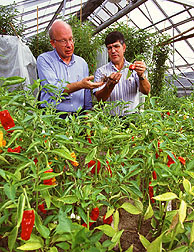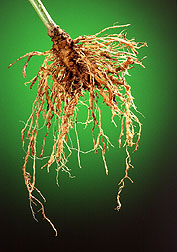For Pepper Growers, Built-in Nematode Resistance
|
|
After many years of fighting, the pepper war between farmers and nematodes continues to rage on. Farmers keep striking with the chemical fumigant methyl bromide, but the nematodes keep coming back. Now farmers face a ban on methyl bromide by the year 2001. This means their main weapon may be taken away and what alternatives will they have for continuing this ongoing struggle?
Fortunately for pepper farmers, they have an unswerving ally in Richard L. Fery. This geneticist with USDA's Agricultural Research
Service in Charleston, South Carolina, has developed bell peppers that have genetic resistance to the southern root-knot nematode, Meloidogyne incognita.
Fery and his research colleagues, who began the bell pepper project at the agency's U.S. Vegetable Laboratory in 1981, have released two resistant varieties, Charleston Belle and Carolina Wonder.
"These are the first commercial nematode-resistant bell peppers, and we think they will be a big help to growers," says Fery.
In 3 years of field and greenhouse tests, Fery showed that both the Charleston Belle and Carolina Wonder are highly resistant to the nematodes. The reason, he says, is a single dominant gene called the N gene, which gives the plant the ability to ward off nematodes that would otherwise infest the roots and eventually weaken or kill the plant.
Considering the ban scheduled on methyl bromide to protect the atmospheric ozone layer, growers welcome this genetic resistance. It could be a key component of an integrated pest management strategy relying on natural pest control methods to reduce dependence on chemicals.
|
|
"Anything that is resistant to insects would be beneficial," says Emilo Davis of the new peppers. He is with Gro-South of Alabama, Inc., in Montgomery. Though Davis does not have severe nematode infestations in his fields, he uses chemicals to control other pests.
The southern root-knot nematode, a microscopic worm that likes sandy, well-drained soil, does its damage by entering a plant's roots and feeding on them. As the nematodes feed, they start to swell, changing from eel-shaped to pear-shaped. They remain in the roots until they die.
Continued feeding by the nematodes eventually begins to reduce the host plant's ability to take in water and nutrients, making it more susceptible to damage from heat and nutritional deficiencies. Once the soil has been infested with the nematodes, it remains infested.
Injecting methyl bromide into the soil 2 to 4 weeks before planting seeds is the most effective way to control nematodes, says David Nagel, a horticulturist at Mississippi State University. Each year, pepper crops account for 12 percent of the methyl bromide used in the United States for soil fumigation.
"Without an alternative, this could become a serious problem," says John VanSickle, professor of Food and Resource Economics at the University of Florida.
|
|
In a 1995 economic study, VanSickle and other researchers calculated the economic costs to the bell pepper industry that would result from a methyl bromide ban. VanSickle's study was aimed at Florida's winter growing season from November through June. It projected that in Florida, losses in sales alone would be $79 million. The total economic loss would be about $127 million, resulting in a loss of about 1,567 full-time jobs.
The VanSickle study estimated the loss of methyl bromide for all farming would cost about $1.045 billion and 13,345 full-time jobs.
The new nematode-resistant peppers could help minimize the losses that will result from a methyl bromide ban.
"Although the peppers and seeds could cost more at the retail level," says Kenneth Jackson of the Degiorgi Seed Company, "the benefits will outweigh the cost."
Both Charleston Belle and Carolina Wonder are dark green when harvested, and they mature to bright-red color. The fruits are sweet, and they look and taste like bell peppers currently in the market. The new peppers, both of the species Capsicum annuum, take from 63 to 70 days to ripen.
Charleston Belle and Carolina Wonder seeds have been offered to about 250 wholesale and retail seed companies for sale to the general public beginning in 1998, says Fery. — By Pat Sanchez.









